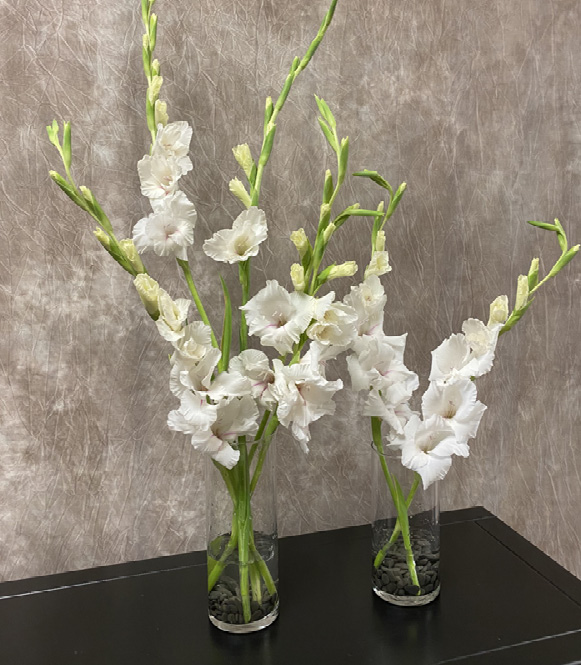Gladiolus for the Farmer Florist
The gladiolus was once known as the sword lily, as its name is derived from the Latin word for sword, gladius, referring to its leaf shape. There are more than 250 species of gladiolus! Gladioli are mainly grown to use as cut flowers rather than for landscape effect. There are two main types of gladioli. Large-flowered types have showy flowers that may have frilled, ruffled, semi-ruffled, or plain petals. Almost all colors, tints, and shades are available. Miniature gladioli are not plain-petaled and small—they are essentially smaller replicas of the ruffled and frilled, large-flowered types.
|
Size class |
Flower diameter (inches) |
|---|---|
|
giant |
over 5½ |
|
large |
4½–5½ |
|
medium |
3½–4½ |
|
small |
2½–3½ |
|
miniature |
under 2½ |
Gladioli come in a wide range of colors and intensities, ranging from pale to light to medium to deep. Available colors include, but are not limited to, white, green, yellow, orange, salmon, pink, red, rose, lavender, violet, and tan.
Production
Corm selection
The gladiolus “bulb” is a modified stem structure called a corm. Choose healthy corms with no discoloration or soft spots. Purchase corms from reputable suppliers to avoid low-quality corms. Corm size correlates to flower size, so choose the largest possible.
New plants are propagated from cormlets, also called cormels. Propagating flower-producing corms from cormlets is a lengthy process, so growers generally discard gladioli corms. Corms are inexpensive when purchased in bulk.
They can be planted safely after the last frost date, from mid-March to mid-April depending on your location in the state. To have an ample supply of cut stems available over time, plant corms in succession, 7–14 days apart.
Some home gardeners dig and store corms for replanting. We recommend keeping corms cool (approximately 50ºF) and dry until planting. Most are perennials in USDA planting zones 8–10.
Cultural practices
Gladioli prefer well-drained soil with a pH range of 6.5–7. Plant in an area that receives full sun and is spaced away from buildings and obstructions as they require good circulation. Gladioli require only average fertility. Follow soil test recommendations. Plant corms 3–5 inches deep and 4–6 inches apart. Space rows 12–36 inches apart. Gladioli require consistent water and will not tolerate wet feet. An inch of water per week is recommended for good spike development.
Insects and diseases
Gladioli are relatively insect- and pest-free. The most common pest is the gladiolus thrips. Very small, these insects are difficult to detect but do considerable damage, especially to the flower spikes.
Most disease issues are corm and stem rots. You can avoid most of these with proper care and storage of the corms.
Harvest and Postharvest Handling
Harvest stage varies depending on when the flowers will be used. If they will be used soon or sold locally, cut stems when the lower two to three florets are showing color or the lowest floret is open. For long-distance shipping or storage for later use, harvest stems when the lowest buds start showing color.
Cut by inserting a sharp knife above the second to fourth leaf and making a slanting cut up the stem. Immerse in clean water immediately to avoid wilting. Gladioli are extremely geotropic, so store in a vertical position to avoid curved stems. Gladioli are also ethylene-sensitive, so it is important to take care when storing with other materials.
Cultivar Recommendations
There are hundreds of gladiolus cultivars available to growers. Choose cultivars based on your needs and clients’ specifications for flower size and color. The cultivar featured here is ‘White Prosperity’.
Design Applications
Gladioli are elegant and timeless cut flowers. They move easily from an informal farmer’s kitchen setting to a chic, cosmopolitan event. Each blossom is fascinating to behold, and their colors can be pure, saturated, or smoky.
These flowers are not necessarily prized for fragrance; there really is none. Our fascination with them is found in their line, pattern, and form. When used in a floral arrangement, gladioli provide structure and give strong vertical movement. If desired, other flowers can be added with them to create mass and bridge gaps to establish form. They are spectacular on their own.
These flowers are so versatile that a bunch of just 10 stems can provide the flowers for a four-person wedding and table centerpiece. Based on the development of a retail sales package by floral industry teacher/trainer Frankie Shelton, you can create a marketable wedding package of two boutonnieres, bride’s bouquet, bridesmaid’s bouquet, and table centerpiece. Of course, this package may not fit the needs of most brides, but it can be used as a marketing device to gain consumer attention and fill the need for an inexpensive wedding.

In our example, we combined our gladioli with locally grown foliage chosen for its pattern and color. We feel this wedding package can be retailed between $200 and $400, depending on the local market. Gladioli corm prices vary based on their quality and size, along with quantity purchased, and cost from 25 cents to $1.50 each. Cut gladioli market prices vary according to quality and season, often from $1 to $2 per stem.
Materials
For this wedding party, you will need 10 stems of ‘Prosperity’ or another gladiolus variety. We harvested arborvitae and Elaeagnus foliage from the South Mississippi landscape. Green stem wrap (stretchy, waxy, paper-based floral tape) and 24-gauge wire complete the simple mechanics for these projects.

Preparing the Florets
To get the greatest number of usable florets, place stems in flower food solution and hold them at room temperature. This allows the flowers to develop and fully unfurl. This process may take a week, so it is important to monitor floral development. Keep in mind that refrigeration is a tool for longevity; remove individual florets and store them in plastic bags in a refrigerator until you’re ready to use them.

Mounting Flowers and Foliage: Wiring Techniques
To create the boutonnieres and bride’s bouquet shown in this publication, remove individual florets from the parent stem. It is important to remove florets from the bottom to the top of the stem to maintain usable and attractive stem terminals for the centerpiece and other designs.
Wire Elaeagnus leaves with intact petioles (the small stem-like appendage at the base of the leaf) using the pierce technique. We like the silvery white color of the leaf undersides. Make sure that just a small portion of the wire is visible (Figure 4). Wire the arborvitae using the wrap-around method, and mount gladiolus florets using the pierce method. After wiring, tape each leaf and floret individually with stem wrap.
Boutonnieres
These boutonnieres use individually wired and taped foliage and the florets from a portion of a gladiolus stem. Note that fully opened florets are probably too large for a jacket lapel, but the buds are perfectly proportionate. This same design can be used for a woman’s shoulder corsage by adding a ribbon bow to the design. Add a pin parallel to the stem so that the person pinning on corsages and boutonnieres is not stuck by the sharp point.

Bride’s Bouquet
To make the wired and taped bridal bouquet, remove open florets, a few buds, and a terminal portion of two to three gladiolus stems. Instead of leaf placements, we used sprigs of Elaeagnus foliage and longer pieces of arborvitae to speed along the design process. Instead of discarding the linear gladiolus foliage, we folded it into loops, bound it with wire, then taped each placement. These loops provide cushioning and spacing structure to the bouquet assembly. Note that after wiring, each placement should be taped before creating the design.

The bride’s bouquet uses materials massed together and has an asymmetrical visual balance. Once the design is complete, mist it heavily with anti-transpirant spray to seal petal and leaf surfaces.

Attendant’s Bouquet
The bridesmaid’s clutch bouquet of gladiolus blooms is tailored and elegant, using the florets from only two stems. If necessary, some of the placements can be wired and taped. This design matches well with the bride’s bouquet yet is smaller. It is a simple yet special statement. Add stems of assorted foliage and bind them together with stem wrap. Though we chose to leave ours plain, a ribbon trim can introduce a second color and add value to the design.

Centerpiece
You can make a petite centerpiece from extra gladiolus florets, but they must remain on the parent stem. This design can be taken along for use at a restaurant or in the home for an intimate reception. Our design uses a 3-inch tall by 5-inch wide glass cylinder container. To keep the flowers in place, create a gridwork of waterproof tape, preferably clear, to anchor wobbly stems and small foliage clippings in place. Florets that are removed from the parent stem can be placed in bowls or bubble vases with just enough water to keep them fresh but not immersed.

Gladioli in Vases
Just a few gladiolus stems in glass cylinders with 3–4 inches of water create a clean, refreshing buffet table or entry design. Add decorative rocks/pebbles to the vases before adding the flowers so that vases do not tumble. Add extra flowers and foliage if desired.

References
Butler, S., DelPrince, J., Fowler, C., Gilliam, H., Johnson, J., McKinley, W., Money-Collins, H., Moss, L., Murray, P., Pamper, K., Scace, P., Shelton, F., Verheijen, A., & Whalen, K. (2005). The AIFD guide to floral design. Intelvid Group.
Dole, J., & Wilkins, H. (2005). Floriculture: Principles and species (2nd edition). Pearson.
Dole, J., Stamps, R., Carlson, A., Ahmad, I., & Greer, L. (2017). Postharvest handling of cut flowers and greens (J. Laushman, Ed.). Association of Specialty Cut Flower Growers.
Hunter, N. (2013). The art of floral design (3rd edition). Delmar.
Johnson, J., McKinley, W., & Benz, B. (2001). Flowers: Creative design. San Jacinto Publishing Co.
Missouri Botanical Garden. (n.d.). Gladiolus (group).
Scace, P. D., & DelPrince, J. (2020). Principles of floral design (2nd edition). Goodheart-Willcox.
Stevens, S., Stevens, A. B., Gast, K. L. B., O’Mara, J. A., Tisserat, N. A., & Bauernfeind, R. (1993). Commercial specialty crop production: Gladiolus. Kansas State University Cooperative Extension Service MF-1080.
Trinklein, D. (2005). Summer flowering bulbs: Gladiolus. University of Missouri Extension G6620.
Wood, M. (2007). The seasonal home. Winward.
The authors wish to thank Corey Wheeler, Research Technician, MSU Coastal Research and Extension Center, for floriculture production assistance.
Publication 3615 (POD-05-24)
By James DelPrince, PhD, Associate Extension Professor, Coastal Research and Extension Center; Christine Coker, PhD, Extension/Research Professor, Coastal Research and Extension Center; and Frankie Shelton, AIFD, PFCI.
The Mississippi State University Extension Service is working to ensure all web content is accessible to all users. If you need assistance accessing any of our content, please email the webteam or call 662-325-2262.



